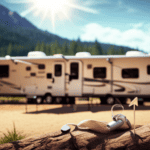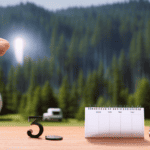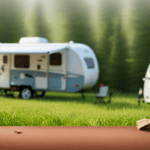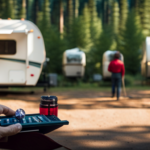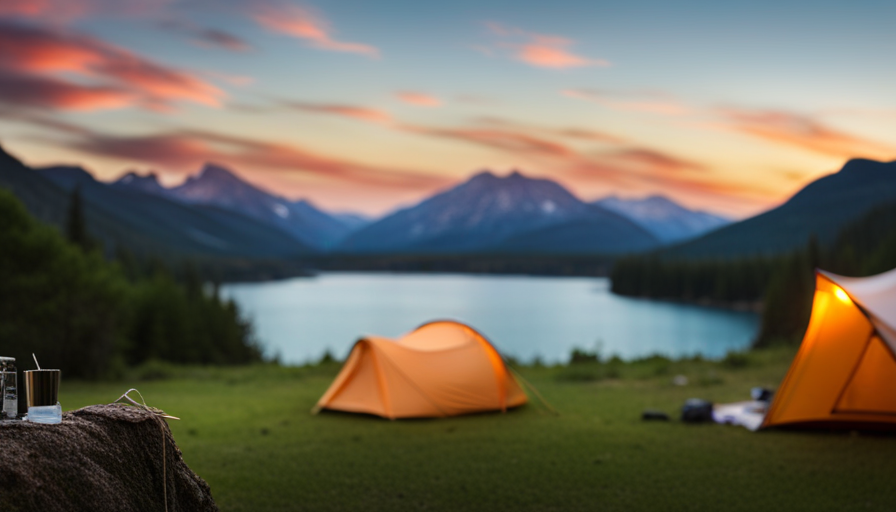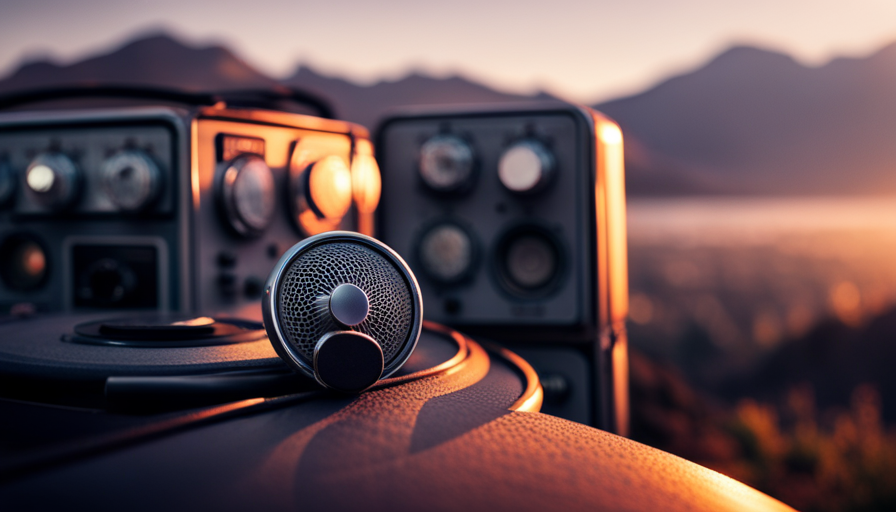Picture this: you’re hitting the open road, feeling the breeze dance through your hair, with the world just waiting for you to explore it at your own leisure. It’s the ultimate adventure many dream of, and having your own camper turns that dream into reality. Now, the big question is, how do you pay for it?
In this article, we will explore the various options available to finance a camper, from short-term to long-term loans. We will discuss the factors that affect loan approval and provide tips for a successful loan application. Additionally, we will delve into refinancing options for existing loans and highlight the resources and support available for camper financing.
So, if you’re ready to hit the road and embark on your next great adventure, read on to discover how long you can finance a camper and make your dreams come true.
Key Takeaways
- Short-term financing options for campers typically last for 1-5 years, allowing for quick loan repayment and avoiding excessive interest charges.
- Personal loans, dealer financing, and credit cards are common short-term financing options for campers.
- Long-term financing options for campers can extend up to 20 years or more, offering smaller monthly payments but potentially higher interest rates and fees.
- Factors such as credit score, income, debt-to-income ratio, down payment, and collateral can affect loan approval for financing a camper.
Understanding Camper Financing Options
You’ll be amazed at the variety of camper financing options available to make your dream of hitting the open road a reality!
When it comes to financing a camper, you have the choice between short term and long term financing options. Short term financing typically lasts for a period of one to five years, while long term financing can extend up to 20 years or more.
Short term financing is appealing to those who want to pay off their camper loan quickly and avoid excessive interest charges. However, it’s important to note that shorter loan terms often come with higher monthly payments.
On the other hand, long term financing allows for smaller monthly payments, making it more manageable for those on a tight budget. However, it’s crucial to consider the total interest paid over the life of the loan, as longer terms can result in higher interest rates and fees.
When comparing financing options, it’s essential to examine the interest rates and fees associated with each. Interest rates can vary depending on your credit score and the lender you choose. Additionally, some lenders may charge extra fees, such as origination fees or prepayment penalties. Taking the time to understand these costs can help you make an informed decision.
Now, let’s delve into the details of short-term financing options and how they can benefit you on your camper financing journey.
Short-Term Financing Options
With a variety of short-term options available, you can quickly secure the funds needed to embark on your dream camping adventure. When it comes to short-term financing options for campers, there are a few choices to consider.
Here are some popular ones:
-
Personal Loans: Personal loans are a common choice for short-term financing. They typically have lower interest rates compared to credit cards, making them a more affordable option. Additionally, personal loans often come with flexible repayment terms, allowing you to choose a loan duration that suits your needs.
-
Dealer Financing: Many camper dealerships offer their own financing options for short-term loans. These loans are specifically designed for purchasing campers and may come with special terms and conditions. Dealer financing can be a convenient option as it allows you to finance your camper purchase directly through the dealership.
-
Credit Cards: While not specifically designed for camper financing, credit cards can be used as a short-term financing option. If you have a credit card with a high enough limit, you can use it to cover the cost of a camper. However, keep in mind that credit cards often have higher interest rates compared to other financing options.
When considering short-term financing options, it’s important to carefully review the terms and conditions of each option. This will ensure that you understand the repayment terms, interest rates, and any additional fees associated with the loan.
By exploring these short-term options, you can find the right financing solution for your camper purchase. Speaking of financing, let’s now delve into long-term financing options for campers.
Long-Term Financing Options
When considering long-term financing options for a camper, there are several key points to keep in mind.
Firstly, long-term loans offer a range of benefits such as lower monthly payments and the ability to spread out the cost over a longer period of time.
Secondly, it’s important to carefully consider the repayment plans and schedule before committing to a long-term loan, as this will determine the total amount paid and the duration of the loan.
Lastly, there are certain considerations to take into account when opting for long-term financing, such as interest rates, fees, and the potential impact on your overall financial situation.
Benefits of Long-Term Loans
Long-term loans for campers are like a warm campfire on a chilly night, providing the benefits of extended financing options. These loans offer several advantages to buyers, making them an attractive choice for those looking to purchase a camper. Firstly, long-term loans allow for smaller monthly payments, making it easier to fit the loan into your budget. Additionally, they provide flexibility in terms of repayment plans and schedules, allowing you to choose a plan that suits your financial situation. Furthermore, these loans often come with competitive interest rates, saving you money in the long run. This table illustrates the benefits of long-term loans:
| Benefits of Long-Term Loans | ||
|---|---|---|
| Smaller Monthly Payments | Flexibility in Repayment | Competitive Interest Rates |
| Longer Loan Terms | Easier Budgeting |
When considering financing options for a camper, long-term loans provide numerous benefits. Now, let’s explore the next section about repayment plans and schedules.
Repayment Plans and Schedule
Immerse yourself in the excitement of planning your repayment plans and schedule for your dream camper, as you envision the adventures that await you on the open road. When it comes to financing a camper, it’s important to understand the repayment options available to you.
Here are three key aspects to consider:
-
Loan Term: Decide on the duration of your loan, keeping in mind that longer terms result in lower monthly payments, but higher overall interest costs.
-
Interest Rates: Compare interest rates from different lenders to find the best deal. Remember, even a small difference in rates can save you thousands of dollars over the life of the loan.
-
Monthly Budget: Calculate your monthly budget and determine how much you can comfortably afford to allocate towards your camper loan repayment.
Considering these factors will help you create a repayment plan that suits your financial goals and aspirations. Moving forward, let’s explore the considerations for long-term financing.
Considerations for Long-Term Financing
As you delve into the realm of extended financing, it’s crucial to carefully evaluate the potential impact on your overall financial stability. This involves considering factors such as interest accrual and the total cost of ownership.
When considering long-term financing options for a camper, there are a few key considerations to keep in mind. Firstly, it’s important to assess your ability to make monthly payments over an extended period of time. This involves analyzing your income, expenses, and budgeting accordingly.
Additionally, you should research and compare interest rates offered by different lenders to ensure you obtain the most favorable terms. It’s also wise to consider the depreciation of the camper over time and whether it aligns with the length of your financing.
By taking these considerations into account, you can make an informed decision that suits your financial situation and goals.
Moving forward, let’s explore the factors affecting loan approval.
Factors Affecting Loan Approval
When it comes to getting approved for a loan, there are several factors that lenders take into consideration. The first is your credit score and history, which shows your track record of managing debt.
The second is your income and debt-to-income ratio, which demonstrates your ability to make monthly payments.
Lastly, the down payment and collateral you can provide can also impact your loan approval.
Credit Score and History
You can easily find out how long you can finance a camper by checking your credit score and history.
Your credit score plays an important role in determining your eligibility for a loan and the terms you will be offered. Lenders consider factors such as credit utilization and payment history to assess your creditworthiness.
A higher credit score often leads to lower loan interest rates and longer financing options. On the other hand, a lower credit score may result in higher interest rates and shorter loan terms.
Understanding your credit score and history can help you make informed decisions when it comes to financing a camper. With this knowledge, you can explore other aspects of loan approval, such as income and debt-to-income ratio, to determine the best financing options for your camper purchase.
Income and Debt-to-Income Ratio
Understanding the importance of your income and debt-to-income ratio is crucial when it comes to securing the best financing options for your dream camper. Lenders want to ensure that you have a stable income that can support the monthly payments on your camper loan. They will also look at your debt-to-income ratio, which is the percentage of your monthly income that goes towards debt payments. A lower ratio indicates a healthier financial situation and makes you a more attractive borrower.
If your income is not sufficient or your debt-to-income ratio is high, you may want to consider options like debt consolidation or loan refinancing to improve your financial standing. Debt consolidation allows you to combine multiple debts into one, potentially lowering your overall monthly payment. Loan refinancing, on the other hand, involves replacing your current loan with a new one that has better terms.
Understanding how your income and debt-to-income ratio impact your ability to finance a camper is essential in finding the best financing options for your needs. Now let’s explore the next aspect of financing: down payment and collateral.
Down Payment and Collateral
Alright, folks, let’s dive into the nitty-gritty of financing your dream camper with the down payment and collateral.
When it comes to down payment alternatives, you have a few options to consider. Some lenders may allow you to make a smaller down payment, while others may require a larger sum upfront. It’s important to explore these alternatives and choose the option that best fits your financial situation.
Additionally, lenders may also require collateral for the loan. This could be the camper itself or another valuable asset that you own. Collateral provides security for the lender in case you default on the loan.
Now that we’ve discussed down payment alternatives and collateral options, let’s move on to preparing for the loan application process and ensuring you have everything in order.
Preparing for the Loan Application Process
When it comes to financing a camper, it’s important to know how long you can finance it. Understanding the loan application process and the factors that affect loan approval is crucial.
The loan application process typically involves filling out an application form, providing documentation of your income and financial situation, and submitting it to the lender. The lender will then evaluate your application based on various factors such as your credit score, debt-to-income ratio, employment history, and the value of the camper you are financing. These factors will determine whether you qualify for a loan and the terms and interest rates you will be offered.
Preparing for the loan application process involves gathering all the necessary documents and ensuring your financial situation is in good shape. This includes checking your credit report for any errors or issues that need to be addressed, paying off any outstanding debts, and saving for a down payment if required. It’s also important to research different lenders and compare their loan options to find the best terms and rates for your camper financing.
When you have a solid understanding of the loan application process and have prepared accordingly, you can move on to negotiating loan terms and rates.
Negotiating Loan Terms and Rates
To get the best deal on your loan, you’ll need to roll up your sleeves and start negotiating the terms and rates. When it comes to financing a camper, negotiating interest rates and loan term options can make a significant difference in the total cost of your loan.
Start by researching current interest rates and comparing them across different lenders. This will give you a baseline to work with during negotiations. Remember, the interest rate determines how much you’ll pay in interest over the life of the loan, so even a small percentage difference can add up to significant savings.
Next, consider the loan term options available to you. A longer loan term may result in lower monthly payments, but it also means paying more in interest over time. On the other hand, a shorter loan term may have higher monthly payments but can save you money in interest in the long run. Assess your financial situation and determine what monthly payment you can comfortably afford.
By negotiating both the interest rate and loan term, you can find a balance that suits your financial needs. Once you have secured favorable terms and rates, you can move on to calculating affordability and monthly payments.
Calculating Affordability and Monthly Payments
Before diving into the process of negotiating loan terms and rates, it’s essential for you to understand how to calculate your affordability and determine the monthly payments that align with your financial situation. To help you navigate this aspect of financing a camper, here are some key points to consider:
-
Calculating Affordability: Take a close look at your monthly income, expenses, and savings to determine how much you can comfortably allocate towards your camper loan payments. Consider factors like insurance, maintenance costs, and potential fluctuations in interest rates.
-
Monthly Payments: Once you’ve calculated your affordability, you can estimate your monthly payments based on different financing options and repayment plans. This will give you a clear idea of how much you’ll need to budget for each month.
-
Financing Options: Research various lenders and their loan terms to find the best fit for your financial situation. Compare interest rates, loan durations, and any potential fees or penalties associated with early repayment.
-
Resources and Support: Utilize online calculators and resources provided by lenders to assist you in determining affordability and monthly payments. Additionally, seek guidance from financial advisors or loan specialists who can provide personalized advice.
Understanding how to calculate affordability and determine monthly payments is crucial for a successful loan application. In the next section, we’ll discuss some helpful tips to increase your chances of securing the loan and making your dream of owning a camper a reality.
Tips for a Successful Loan Application
Consider these helpful tips to boost your chances of successfully securing a loan and turning your dream of owning a camper into a reality. When applying for a loan, it’s important to understand the loan requirements and the loan approval process. Here are some tips to help you navigate through the application process smoothly.
First, make sure you meet the minimum requirements set by the lender. These requirements may include a minimum credit score, a stable source of income, and a reasonable debt-to-income ratio. Meeting these requirements will increase your chances of loan approval.
Next, gather all the necessary documents before applying for the loan. This may include proof of income, employment verification, bank statements, and identification documents. Having these documents ready will speed up the application process and show the lender that you are organized and prepared.
Additionally, it’s important to maintain a good credit score. Pay your bills on time, avoid taking on unnecessary debt, and keep your credit utilization low. A strong credit score will demonstrate to the lender that you are a responsible borrower.
Lastly, consider getting pre-approved for a loan. This will give you a clear understanding of your budget and show sellers that you are a serious buyer.
By following these tips, you can increase your chances of loan approval and get one step closer to owning your dream camper. In the next section, we will explore refinancing options for existing loans.
Refinancing Options for Existing Loans
When it comes to refinancing your existing loan, you’ll want to explore the different options available to make sure you’re getting the best deal possible.
Refinancing your camper loan can have several benefits, including potentially lowering your interest rate, reducing your monthly payments, or even shortening the length of your loan term.
The refinancing process typically involves applying for a new loan with a different lender to pay off your current loan. This can be done through traditional lenders such as banks or credit unions, or through online lenders that specialize in camper refinancing.
Before deciding on a refinancing option, it’s important to consider your current financial situation and goals. Take the time to compare interest rates and loan terms from different lenders to ensure you’re getting the best possible deal.
Additionally, be aware of any fees or penalties associated with refinancing your loan, as these can impact the overall cost savings.
In the next section, we will explore resources and support available for camper financing, which can provide valuable information and assistance throughout the loan process.
Resources and Support for Camper Financing
Navigating the world of camper financing can feel like venturing into uncharted waters, but fear not, for there are resources and support available to guide you through the process. When it comes to camper financing options, it’s important to understand the different avenues you can explore to make your dream of owning a camper a reality.
Here are some resources and support to consider when financing a camper:
-
Financial institutions: Banks, credit unions, and online lenders offer camper loans with varying interest rates and terms. Research different lenders to find the best option for your financial situation.
-
Dealership financing: Many camper dealerships offer in-house financing options. This can be convenient, but be sure to compare rates and terms with other lenders to ensure you’re getting the best deal.
-
Online resources: Websites and forums dedicated to camper enthusiasts often have valuable information on financing options and loan qualification. These resources can provide insights from experienced owners and help you make informed decisions.
-
Credit counseling: If you’re unsure about your creditworthiness or need assistance improving your credit score to qualify for a camper loan, consider seeking help from a credit counseling agency. They can provide guidance on managing your finances and improving your creditworthiness.
-
Camper loan qualification: Before applying for a loan, it’s important to understand the requirements for qualification. Lenders typically consider factors such as credit score, income, and debt-to-income ratio. Being aware of these criteria can help you prepare and increase your chances of approval.
By utilizing these resources and support systems, you can navigate the world of camper financing with confidence, making your dream of hitting the road in your own camper a reality.
Frequently Asked Questions
What are the different types of campers available for financing?
There are various types of campers available for financing, each with its own advantages. Some popular options include travel trailers, motorhomes, and pop-up campers.
Travel trailers offer the advantage of being towable, while motorhomes provide the convenience of a self-contained unit.
Pop-up campers are compact and easy to store. Before financing a camper, factors to consider include your budget, desired features, and maintenance costs.
Owning a camper allows for freedom and flexibility to travel and explore the great outdoors.
Can I finance a used camper?
Yes, you can finance a used camper. When it comes to financing options for used campers, there are several routes you can take. Many lenders, including banks and credit unions, offer loans specifically for used campers. The interest rates for financing a used camper may vary depending on factors such as your credit score and the age of the camper. It’s important to shop around and compare rates to ensure you get the best deal.
Are there any specific credit requirements for camper financing?
When it comes to financing a camper, credit score and loan terms are key factors to consider. Lenders typically have specific credit requirements in order to qualify for camper financing. A good credit score will increase your chances of securing a loan with favorable terms.
As for the loan terms, they can vary depending on the lender and your financial situation. It’s important to research and compare different options to find the best fit for you.
Can I use the camper as collateral for the loan?
Yes, you can use the camper as collateral for the loan. Using the camper as collateral can have its pros and cons.
The main advantage is that it may help you secure a lower interest rate and potentially borrow a larger amount. However, the downside is that if you default on the loan, you could lose your camper.
Additionally, using the camper loan for other purposes may limit your ability to sell or trade-in the camper in the future.
Are there any tax benefits or incentives for financing a camper?
Tax deductions and financing options for campers can provide financial benefits. One interesting statistic is that the IRS allows certain deductions for campers used as a second home. This can potentially reduce your taxable income and save you money.
Additionally, financing options such as extended loan terms and low interest rates make campers more affordable. Consider exploring these incentives and options to make your dream of owning a camper a reality.
What Is the Typical Financing Period for a Camper?
When considering purchasing a camper, it’s important to explore the various financing options for campers available. The typical financing period for a camper can range from anywhere between five to 20 years, depending on the loan terms and the individual’s financial situation. It’s essential to thoroughly research and compare the different financing options to ensure you choose the one that aligns best with your needs and budget.
Conclusion
In conclusion, financing a camper can provide you with the opportunity to explore the great outdoors and create lasting memories.
Whether you choose a short-term or long-term financing option, it’s important to consider factors such as loan approval criteria and monthly payments.
For example, let’s say John and his family decided to finance a camper for 10 years. They were able to secure a loan with a low interest rate, allowing them to comfortably make monthly payments while still enjoying their camping adventures.
With proper preparation and research, you can find the right financing option that fits your budget and lifestyle.



